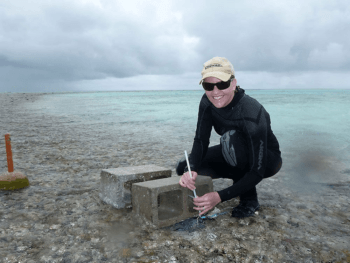Trying To Restore Health To Coral Reefs

By increasing the alkalinity levels of seawater on a coral reef – essentially turning back the clock 100 years when carbon dioxide levels in the atmosphere were lower and the oceans were healthier — it is possible to increase the growth of the reef, according to a team of international scientists that includes a Texas A&M University researcher.
Kathryn Shamberger, assistant professor of oceanography at Texas A&M, and colleagues from the Carnegie Institution for Science, Stanford, the University of California-Davis, Cornell, the University of Sydney, Rice University, the Hebrew University of Jerusalem, the Institute for Oceanographic and Limnological Research-Haifa, the Woods Hole Oceanographic Institution and the Max Planck Institute have had their findings published in the current issue of Nature magazine.
It is widely known that about one-fourth of the man-made carbon dioxide released into the atmosphere has found its way into the world’s oceans. When fragile ecosystems such as coral reefs come in contact with water that contains above-normal levels of carbon dioxide, the reefs become stressed and their growth slows due to a process called ocean acidification.
It has been predicted that ocean acidification will cause the deterioration of coral reefs worldwide sometime this century.
The team examined a reef called One Tree Reef, part of the southern Great Barrier Reef off the Australian coast, the world’s largest coral reef system. Water flows across part of One Tree Reef as one lagoon drains into another at low tide, and during low tide they added sodium hydroxide to the water to increase alkalinity levels and reverse acidification – in effect, they changed the ocean chemistry of water in and around the reef.
“The reef responded to the alkalinity addition by growing faster during our experiments,” Shamberger explains. “We believe this is the first time anyone has restored water chemistry on a natural coral reef and measured a biological response when acidification was reversed.”
“Carbon dioxide levels in the world’s oceans have been increasing since the Industrial Revolution,” she adds.
“We were able to restore the chemistry of the waters around this section of reef closer to what it was before the Industrial Revolution and this improved growth of the reef. This is evidence that ocean acidification has already slowed coral reef growth.”
The Industrial Revolution was the process of transitioning to new manufacturing methods that began about the mid-1700s to about 1840 and was the start of the factory system. But the era saw huge increases in carbon dioxide emissions as a result of the thousands of new factories burning fossil fuels, and this led to industrial pollution on a worldwide scale.
Coral reefs can be a barometer of healthy ocean conditions. Though they cover less than 1 percent of the ocean, coral reefs are ecosystems that are home to at least one-fourth of all marine life.
“Ocean acidification is happening in every ocean on Earth,” Shamberger adds.
“We do know that adding carbon dioxide to the atmosphere, from burning fossil fuels and deforestation, causes ocean acidification, so it is important for us to understand how coral reefs around the world are responding to this process.”
The study was funded by the Carnegie Institution for Science and the Fund for Innovative Climate and Energy Research.
Media contact: Keith Randall, Texas A&M News & Information Services.





